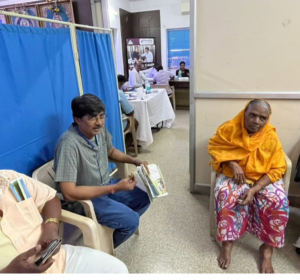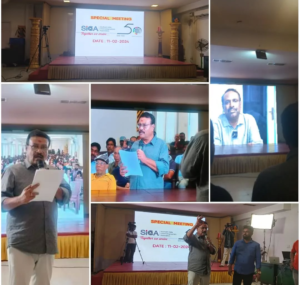
SICA: 53 years! Founding day !!
Nov 27 2025
SICA – 53 Years of Legacy, Leadership & the Light Behind Southern Indian Cinema
(Southern India Cinematographers’ Association)

Southern India Cinematographers Association (SICA) stands today as one of the most respected and influential cinematographers’ bodies in the country—an organization rooted in strong trade-union values, artistic excellence, and an unbroken tradition of unity. With over 2,000 members, including National Award winners, internationally recognised cinematographers, and a thriving community of assistants and aspiring artists, SICA continues to remain the backbone of visual storytelling in Indian cinema.
Origins: Where Trade Unionism Met Art
The story of SICA is intertwined with the very evolution of trade unionism in the Southern film industry.
Trade union culture in cinema began in Madras when Late Sri. Ramnath formed the Cine Technicians Association of South India—a fellowship-oriented body under the Societies Act.
The first official trade union emerged in 1956 with the registration of the Cine Technicians Guild of South India (CTG), guided by the pioneering cinematographer Sri. Nimai Ghosh, who moved from Bengal to Madras and dedicated his life to the community.
As the film industry expanded, it became essential to form unions for each craft. Fourteen years later, seventeen cinematographers joined together to establish a separate body exclusively for the camera fraternity.

Thus, on 27 November 1972, the Southern India Cinematographers Association—SICA—was officially registered under the Trade Union Act of 1926, with:
- Mr. A. Vincent – Founder President
- Mr. P. N. Sundaram – General Secretary
- Mr. S. Maruthi Rao – Treasurer
The first office operated from Mr. Sundaram’s residence in Doraisamy Road, where passionate night-long meetings shaped the foundation of unity, equality, and justice.
Unity Beyond Boundaries
From the beginning, SICA embraced members from Madras, Mysore, Kerala, and Andhra Pradesh, with no barriers of caste, creed, region, or religion—a remarkable social statement for its time.
Purpose & Historic Interventions
SICA’s earliest mission was simple yet revolutionary:
to negotiate fair working conditions for cinematographers and camera department crew.
It championed:
- Fair wages
- Safer working environments
- Job security
- Rights of assistants working in studios and outdoor units
- Protection from exploitation
These efforts eventually contributed to the formation of the Film Employees Federation of South India (FEFSI), the apex body uniting multiple craft unions.
Despite resistance from certain sections of the industry, SICA protected its members from attempts to fragment the community, preserving technician unity in the South Indian film ecosystem.
A Legacy of Growth & Technical Leadership
Across five decades, SICA has evolved beyond its trade-union role and become a centre of technical excellence.

1. Workshops & Training for New Members
SICA conducts structured four-session workshops designed to strengthen fundamentals of cinematography. The sessions include:
- Camera operations
- Optics & lenses
- Lighting techniques
- AI-based cinematography practices
- On-floor demos with the newest equipment



2. Technology Demonstrations
Members receive hands-on demonstrations of the latest:
- Digital cameras
- Lenses
- Lighting equipment
- Imaging technologies
- Artificial Intelligence tools changing the future of production
3. Knowledge Sharing & Publications : SICA website

SICA publishes regular articles, technical breakdowns, interviews with senior cinematographers, and updates on emerging trends—keeping members aligned with global industry changes.
SICA website articles been read by visual story tellers around the globe.
4. SICA App — A Digital Bridge


The mobile app empowers members by:
- Creating job opportunities
- Sharing workshops & industry updates
- Providing access to welfare schemes
- Strengthening communication within the community
5. Film Screenings & Discussions


SICA screens films shot by its cinematographers in a preview theatre, followed by in-depth discussions on craft, techniques, and visual grammar—an invaluable platform for learning.
6. Welfare Schemes & Social Commitment



A cornerstone of SICA’s achievements includes:
- Health programs
- Financial support initiatives
- Family welfare schemes
- Educational support for school & college admissions
- Insurance and emergency assistance
Current Leadership & Vision



Under the dynamic leadership of:
- President – A. Karthik Raaja
- General Secretary – Ilavarasu
- Treasurer – Sakti Saravanan
SICA is focusing on preparing cinematographers for futuristic changes in the medium—digital workflows, virtual production, AI, and new-age imaging.
Their collective vision strengthens:
- Member empowerment
- Upgradation of skills
- Transparent welfare schemes
- Promotion of healthy industry practices
- Stronger global presence for South Indian cinematographers
53 Years of Pride
As SICA celebrates its 53rd Founding Day, it stands as a symbol of:
- Trade union strength
- Technical mastery
- Artistic legacy
- Community welfare
- Unbroken unity among cinematographers
What began in a small room on Doraisamy Road is now one of India’s most powerful cinematography communities—defending rights, shaping careers, and elevating the craft of visual storytelling across Southern India.
Article drafted by
CJ Rajkumar
Author/ Cinematographer
